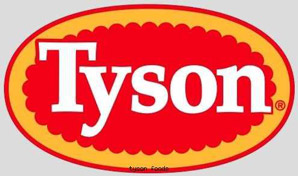Tyson Foods: How John Tyson Turned 500 Chicks Into 23 Billion Dollars Meat Business
In 1931, John Tyson, with his wife and their one year old son, Don, moved to Springdale, Arkansas where he made a living by hauling hay, fruits, and chickens for local growers. In 1935, having heard about the price of chickens being higher in Chicago and other Northern states, Tyson decided to buy and take his chickens from Arkansas to Chicago.
With his savings and additional borrowed money, and strong belief he would make good profit selling chickens outside Arkansas border, Tyson set out to Chicago with 500 chickens. True to his belief, he sold the birds and made a profit of $235. He wired home $220 to settle his debt and to pay for another batch of chickens.
From that beginning, Tyson continued hauling chickens to Northern markets. Before the end of the year, he had extended his market to include Cincinnati, Detroit, Cleveland, Memphis, and Houston. In response to the scarcity of baby chicks, which affected his business, Tyson bought a hatchery. He also started a commercial feed business when he couldn’t get the feeds he needed. And in 1937, he named his company Tyson Feed & Hatchery.
By 1943, Tyson’s company was vertically integrated. It owned its chicks, the feeds to nourish them, and the trucks to haul them to the market place to sell them. And to establish his business firmly, he decided to invest in grower farm.
The 1960s began with a difficult year for Tyson Feed & Hatchery as broiler prices remained low compared to cost of producing them. To sustain its business, Tyson diversified into the commercial egg business and the building of new offices in downtown Springdale.
In 1963, Tyson & Hatchery went public and offered 100,000 shares of stocks for $10.50 a share, and the company’s name became Tyson’s Foods, Incorporated. The company made its first acquisition by buying the Garrett Poultry Company. Sadly, in 1966, John Tyson and his wife died in an automobile accident, and their son, Don took over the running of the company.
He formulated the company’s first corporate strategy, when he said that the company was not strictly committed to the broiler market, but a great deal to ensuring that its investors’ funds brought adequate returns to them. This strategy allowed Tyson Foods to diversify to profitable related businesses
The company’s name was changed to Tyson Foods, Inc. in 1971, with its broiler production reaching 72 million. It invested in a computerized feed mill in Springdale, Arkansas, a new processing plant at Nashville, and two additional acquisitions. These almost doubled the size of the company.
As the ’70 closes, Tyson’s production reached 4.5 million chickens per week, and the company was also the nation’s biggest producer of hog. The company continued its growth by acquiring Krispy Kitchens, Ocoma Foods, Vantress Pedigree and the Wilson Food Corporation.
The 1980s began with Tyson Foods acquiring Honeybear Foods in Neosho, Missouri, and the company’s Chick ‘n Quick line gaining lots of ground in grocery stores, eventually becoming the only chicken patty brand sold in the whole of America by 1982.
In 1983, Tyson Foods bought Mexican Original® in Fayetteville, Arkansas as the company continued to diversify its array of products. The following year, the company hit $1 billion in sales, and continuing its acquisition strategy for growth, it bought Valmac, the Arkansas-based poultry. The purchase brought Tyson Foods about $400 million annual sales, and many major restaurant accounts. And by 1986, Tyson Foods was the biggest poultry producer in the U.S. ahead of ConAgra.
In 1989, Tyson Foods made one of its biggest and profitable acquisitions in its history when it bought Holly Farms. The purchase of Holly Farms doubled Tyson Foods’ size, bringing its annual sales to over $2.5 billion, and its employees to about 48,000. Holly Farms brought Tyson Foods into the beef and pork processing business.
Going international, Tyson Foods formed partnership with Trasgo, a Mexican poultry company to establish an international partnership with Mexico and Japan, known as CITRA.
By 1994, Tyson was undisputed leader in poultry production with sales topping $5.11 billion. The company began aggressive international expansion with the formation of a joint venture in China in 1994, and the formation of a subsidiary, World Resource, Inc. in 1995 to help Tyson’s customers worldwide to source products. The company’s international sales brought in about $500 million.
Tyson solidified its position as the world’s largest poultry producer in 1998 by buying Hudson Foods, the fourth largest poultry producer for $642.4 million, thereby increasing its share of the market to 30 percent.
The late 1990s saw the poultry industry in a dip, with oversupply of poultry products and low prices taking a big toll on operators. To deal with this, Tyson took a number of measures to streamline and restructure the company. These included selling off some of its non-chicken businesses, including its seafood and pork businesses in 1999.
In 2001, Tyson Foods bought IBP, the world’s largest processor of beef for $4.4 billion. Tyson Foods had always tried diversifying into related non-chicken products, but had never been successful, until the purchase of IBP.
The acquisition of IBP gave one-quarter of the market for all beef processed in the U.S. to Tyson Foods, making Tyson Foods the largest diversified meat company in the world valued at $23 billion in 2001. By 2002, Tyson’s revenue had soared to $5.9 billion.
Read Tyson Foods Business Success Strategies Here
………………………………..
Recommended
Put your business on the path to success with a solid plan created with Business Plan Pro Software .
Experts in business and technology, as well as daily users rate this software higher and above others. Click here to see why
